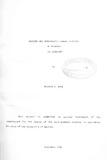| dc.description.abstract | Using the 1979 Kenya census data, this study examines and
analyses some demographic and origin characteristics of the one-year
migrants to Mombasa Town.
The analytical techniques used include percentages, bar' graphs
and line charts which are used to portray the most migratory age groups,
sex by age groups, and the district of origin. The study found that the
male migrants constitute 52 percent of the total migrants to Mombasa
town, while the females constitute 48 percent. It was further noted that
it is the young people who had migrated to Mombasa in the one ypar
particularly those between ages 15-··29. As for the d i strict of origin,
Kitui was found to have the highest one year migrants to Mombasa.
In view of these findings, the study concludes that the
constant ration of migrants into Mombasa in the Young population cripples
employment. educational and training opportunities in the town.
One major recommendation arising from this study is that since
migrants continue moving to the town as long as prospects appear'
brighter than in other towns. employment and training opportunities
should be diversified in those other towns throughout the country for the
purpose of attracting some of the migrants. | en |

